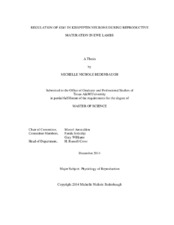| dc.contributor.advisor | Amstalden, Marcel | |
| dc.creator | Bedenbaugh, Michelle Nichole | |
| dc.date.accessioned | 2015-04-28T15:21:42Z | |
| dc.date.available | 2016-12-01T06:36:06Z | |
| dc.date.created | 2014-12 | |
| dc.date.issued | 2014-08-28 | |
| dc.date.submitted | December 2014 | |
| dc.identifier.uri | https://hdl.handle.net/1969.1/153860 | |
| dc.description.abstract | The pubertal initiation of a high-frequency, pulsatile release of gonadotropin-releasing hormone (GnRH) involves an escape from estradiol negative feedback. Kisspeptin neurons are proposed to mediate the effects of estradiol, and estrogen receptor alpha (ESR1) may play a role in this process. The present study investigated the hypothesis that reduced ESR1 expression in kisspeptin neurons is associated with decreased sensitivity to estradiol negative feedback that underlies reproductive maturation. Ewe lambs were ovariectomized at approximately 24 wk of age and received no implant (OVX; n=7) or received a subcutaneous implant containing estradiol (OVX+E; n=14). At 30 wk of age, blood samples were collected to characterize the pattern of luteinizing hormone (LH) secretion. Lambs were then euthanized and a block of tissue containing the preoptic area (POA) and hypothalamus was collected. Detection of ESR1 mRNA and kisspeptin was performed by dual-label in situ hybridization/immunocytochemistry. The abundance of ESR1 mRNA in the middle arcuate nucleus (mARC) was greater in OVX than in OVX+E ewe lambs but did not differ between groups in any other hypothalamic area investigated. Posthoc analysis of the LH data obtained from OVX+E lambs indicated three distinct patterns of LH release: low (1-2 pulses/12 h; n=3), moderate (6-7 pulses/12 h; n=6) and high (>10 pulses/12 h; n=5) frequency of LH pulses. The proportion of kisspeptin cells containing ESR1 mRNA in the POA/periventricular area did not differ among OVX+E lambs exhibiting low, moderate and high frequency of LH pulses. However, the proportion of kisspeptin cells containing ESR1 mRNA in the mid ARC was greater in OVX+E lambs exhibiting high frequency of LH pulses (0.57) than in lambs exhibiting moderate (0.36) or low (0.27) LH pulsatility, and did not differ from OVX (0.50) lambs. Contrary to our hypothesis, the increase in LH pulsatility in maturing ewe lambs is associated with enhanced ESR1 expression in kisspeptin neurons in the ARC. This indicates that the mechanism of decreased sensitivity to estradiol negative feedback during maturation of the reproductive neuroendocrine axis does not involve limiting ESR1 transcription in kisspeptin neurons. | en |
| dc.format.mimetype | application/pdf | |
| dc.language.iso | en | |
| dc.subject | Neuroendocrinology | en |
| dc.subject | Kisspeptin | en |
| dc.subject | ESR1 | en |
| dc.subject | Sheep | en |
| dc.subject | Puberty | en |
| dc.title | Regulation of ESR1 in Kisspeptin Neurons during Reproductive Maturation in Ewe Lambs | en |
| dc.type | Thesis | en |
| thesis.degree.department | Animal Science | en |
| thesis.degree.discipline | Physiology of Reproduction | en |
| thesis.degree.grantor | Texas A & M University | en |
| thesis.degree.name | Master of Science | en |
| thesis.degree.level | Masters | en |
| dc.contributor.committeeMember | Sohrabji, Farida | |
| dc.contributor.committeeMember | Williams, Gary L | |
| dc.type.material | text | en |
| dc.date.updated | 2015-04-28T15:21:42Z | |
| local.embargo.terms | 2016-12-01 | |
| local.etdauthor.orcid | 0000-0002-0545-1068 | |


